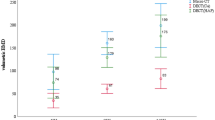Summary
Quantitative computed tomography (QCT) was used to quantitate the structural strength and local material properties of healing tibial osteotomies in 32 dogs. Dogs were divided into four equal groups, euthanatized at either 2, 4, 8, or 12 weeks and imaged with QCT. Invasive techniques were used to determine (1) the torsional properties of the bone; (2) the local stiffness properties and calcium content within the bone; and (3) histologically determined new bone formation and porosity. QCT was strongly associated with the maximum torque (R2=0.44) and torsional stiffness (R2=0.69) of the healing bone. QCT had strong correlations with the local stiffness (R2=0.64), calcium content (R2=0.61), new bone (R2=0.84), and porosity (R2=0.84) of healing tissues.
Similar content being viewed by others
References
Mazess RB (1983) Noninvasive bone measurements. In: Kunin A (ed) Skeletal research II. Academic Press, New York, p 277
Aro HT, Wahner HW, Kelly PJ, Chao EYS (1989) Comparison of stable transverse and unstable oblique osteotomy healing in the canine tibia under external fixation. Trans Orthop Res Soc 14:121
McBroom RJ, Hayes WC, Edwards WT, Goldberg RP, White AA (1985) Prediction of vertebral body compressive fracture using quantitative computed tomography. J Bone Joint Surg 67-A:1206–1214
Cann CE (1988) Quantitative CT for determination of bone mineral density: a review. Radiology 166:509–522
Eriksson SAV, Isberg BO, Lindgren JU (1989) Prediction of vertebral strength by dual photon absorptiometry and quantitative computed tomography. Calcif Tissue Int 44:243–250
Ruegsegger P, Niederer P, Anliker M (1974) An extension of classical bone mineral measurements. Ann Biomed Eng 2:194–205
Reich NE, Seidelmann FE, Tubbs RR (1976) Determination of bone mineral content using CT scanning. AJR 127:593–594
Isherwood I, Rutherford RA, Pullan BR, Adams PH (1976) Bone mineral estimation by computer-assisted transverse axial tomography. Lancet 1:712–715
Posner I, Griffiths HJ (1979) Comparison of CT scanning with photon absorptiometric measurement of bone mineral content in the appendicular skeletal. Invest Radiol 12:542–544
Genant HK, Boyd DP (1977) Quantitative bone mineral analysis using dual-energy computed tomography. Invest Radiol 12:545–551
Revak DS (1980) Mineral content of cortical bone measured by computed tomography. J Comput Assist Tomogr 4:342–350
Alho A, Husby T, Høseth A (1988) Bone mineral content and mechanical strength. Clin Orthop 227:292–297
Rand JA, An KN, Chao EYS, Kelly PJ (1981) A comparison of the effect of open intramedullary nailing and compression-plate fixation on fracture-site blood flow and fracture union. J Bone Joint Surg 63-A:428–442
Harris WH, Lavorgna J, Hamblen DL, Haywood EA (1968) The inhibition of ossification in vivo. Clin Orthop 61:52–60
Cann CE, Genant HK, Kolb FO, Ettinger B (1985) Quantitative computed tomography for prediction of vertebral fracture risk Metab Bone Dis Rel Res 6:1–7
Genant HK, Cann CE, Ettinger B, Gordon GS, Kolb FO, Reiser U, Arnaud CD (1985) Quantitative computed tomography for spinal mineral assessment: current status. J Comput Assist Tomogr 9:602–604
Sartoris DJ, Andre M, Resnick C, Resnick D (1986) Trabecular bone density in the proximal femur: quantitative CT assessment. Radiology 160:707–712
Falkenberg J (1961) An experimental study of the rate of fracture healing. Acta Orthop Scand (Suppl 50)
Burstein AH, Frankel VH (1971) A standard test for laboratory animal bone. Technical note. J Biomech 4:155–158
Sammarco GJ, Burstein AH, Davis WL, Frankel VH (1971) The biomechanics of torsional fractures: the effect of loading on ultimate properties. J Biomech 4:113–117
Aitken GK, Bourne RB, Finlay JB, Rorabeck CH, Andreae PR (1985) Indentation stiffness of the cancellous bone in the distal human tibia. Clin Orthop 201:264–270
Johnson JA, Krug WH, Nahon D, Miller JE, Ahmed AM (1983) An evaluation of the load-bearing capability of the cancellous proximal tibia with special interest in the design of knee implants. Trans Orthop Res Soc 8:403
Josefchak RG, Finlay JB, Bourne RB, Rorabeck CH (1987) Cancellous bone support for patellar resurfacing. Clin Orthop 220:192–199
Aro HT, Wippermann BW, Hodgson SF, Wahner HW, Lewallen DG, Chao EY (1989) Prediction of properties of fracture callus by measurement of mineral density using micro-bone densitometry. J Bone Joint Surg 71A:1020–1030
Markel MD, Wikenheiser MA, Chao EYS (1990) A study of fracture callus material properties: relation to the torsional strength of bone. J Orthop Res 8:843–850
Nixon DE, Moyer TP, Johnson P, McCall JT, Ness AB, Fjerstad WH, Wehde MB (1986) Routine measurement of calcium, magnesium, copper, zinc, and iron in urine and serum by inductively coupled plasma emission spectroscopy. Clin Chem 32:1660–1665
Baron R, Vignery A, Neff L, Silverglate A, Maria AS (1979) Processing of undecalcified bone specimens for bone histomorphometry. In: Recker RR (ed) Bone histomorphometry techniques and interpretation. CRC Press, Boca Raton, p 13
Jowsey J, Kelly PJ, Riggs BL, Bianco AJ, Scholz DA, Gershon-Cohen JG (1965) Quantitative microradiographic studies of normal and osteoporotic bone. J Bone Joint Surg 47A:785–806
Lewallen DG, Aro HT, Chao EYS, Berquist TH, Kelly PJ (1988) Noninvasive evaluation of bone healing using quantitative MRI imaging. Trans Orthop Res Soc 13:409
Frost HM (1979) Bone histomorphometry: choice of marking agent and labeling schedule. In: Recker RR (ed) Bone histomorphometry techniques and interpretation. CRC Press, Boca Raton, p 38
Cruess RL, Dumont J (1975) Fracture healing. Can J Surg 18:403–413
Sevitt S (1980) Healing of fractures in man. In: Owen R, Goodfellow J, Bullough P (eds) Scientific foundations of orthopedics and traumatology. WB Saunders, Philadelphia, p 258
Hulth A (1989) Current concepts of fracture healing. Clin Orthop 249:265–284
Morgan CL (1983) Introduction to tomography and principles of computed tomography. In: Basic principles of computed tomography. University Park Press, Baltimore, p 1
Author information
Authors and Affiliations
Rights and permissions
About this article
Cite this article
Markel, M.D., Morin, R.L., Wikenheiser, M.A. et al. Quantitative CT for the evaluation of bone healing. Calcif Tissue Int 49, 427–432 (1991). https://doi.org/10.1007/BF02555855
Received:
Revised:
Issue Date:
DOI: https://doi.org/10.1007/BF02555855




